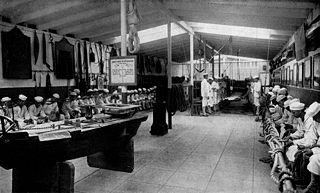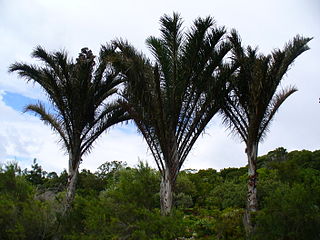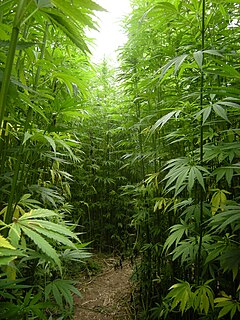Related Research Articles

Abacá, binomial name Musa textilis, is a species of banana native to the Philippines, grown as a commercial crop in the Philippines, Ecuador, and Costa Rica. The plant, also known as Manila hemp, has great economic importance, being harvested for its fiber, also called Manila hemp, extracted from the leaf-stems. Abacá is also the traditional source of lustrous fiber hand-loomed into various indigenous textiles in the Philippines like t'nalak, as well as colonial-era sheer luxury fabrics known as nipis. They are also the source of fibers for sinamay, a loosely woven stiff material used for textiles as well as in traditional Philippine millinery.

A knot is an intentional complication in cordage which may be practical or decorative, or both. Practical knots are classified by function, including hitches, bends, loop knots, and splices: a hitch fastens a rope to another object; a bend fastens two ends of a rope to each another; a loop knot is any knot creating a loop, and splice denotes any multi-strand knot, including bends and loops. A knot may also refer, in the strictest sense, to a stopper or knob at the end of a rope to keep that end from slipping through a grommet or eye. Knots have excited interest since ancient times for their practical uses, as well as their topological intricacy, studied in the area of mathematics known as knot theory.
Splice may refer to:
A whipping knot or whipping is a binding of marline twine or whipcord around the end of a rope to prevent its natural tendency to fray.

Kinbaku (緊縛) means "tight binding," while Kinbaku-bi (緊縛美) literally means "the beauty of tight binding." Kinbaku is a Japanese style of bondage or BDSM which involves tying a person up using simple yet visually intricate patterns, usually with several pieces of thin rope (often jute, hemp or linen and generally around 6 mm in diameter, but sometimes as small as 4 mm, and between 7–8 m long. In Japanese, this natural-fibre rope is known as asanawa; the Japanese vocabulary does not make a distinction between hemp and jute. The allusion is to the use of hemp rope for restraining prisoners, as a symbol of power, in the same way that stocks or manacles are used in a Western BDSM context. The word shibari came into common use in the West at some point in the 1990s to describe the bondage art Kinbaku. Shibari is a Japanese word that broadly means "binding" or "tying" in most contexts, but is used in BDSM to refer to this style of decorative bondage.

Team roping also known as heading and heeling is a rodeo event that features a steer and two mounted riders. The first roper is referred to as the "header", the person who ropes the front of the steer, usually around the horns, but it is also legal for the rope to go around the neck, or go around one horn and the nose resulting in what they call a "half head". Once the steer is caught by one of the three legal head catches, the header must dally and use his horse to turn the steer to the left.

A rope is a group of yarns, plies, fibers or strands that are twisted or braided together into a larger and stronger form. Ropes have tensile strength and so can be used for dragging and lifting. Rope is thicker and stronger than similarly constructed cord, string, and twine.

Ropework or marlinespike seamanship are traditional umbrella terms for a skillset spanning the use, maintenance, and repair of rope. Included are tying knots, splicing, making lashings, whippings, and proper use and storage of rope.

Fiber crops are field crops grown for their fibers, which are traditionally used to make paper, cloth, or rope.

Raffia palms (Raphia) are a genus of about twenty species of palms native to tropical regions of Africa, and especially Madagascar, with one species also occurring in Central and South America. R. taedigera is the source of raffia fibers, which are the veins of the leaves, and this species produces a fruit called "brazilia pods", "uxi nuts" or "uxi pods".

Hemp, or industrial hemp, is a variety of the Cannabis sativa plant species that is grown specifically for industrial use. It can be used to make a wide range of products. Along with bamboo, hemp is one of the fastest growing plants on Earth. It was also one of the first plants to be spun into usable fiber 50,000 years ago. It can be refined into a variety of commercial items, including paper, rope, textiles, clothing, biodegradable plastics, paint, insulation, biofuel, food, and animal feed.
Cable may refer to:
Ultra-high-molecular-weight polyethylene is a subset of the thermoplastic polyethylene. Also known as high-modulus polyethylene, (HMPE), it has extremely long chains, with a molecular mass usually between 3.5 and 7.5 million amu. The longer chain serves to transfer load more effectively to the polymer backbone by strengthening intermolecular interactions. This results in a very tough material, with the highest impact strength of any thermoplastic presently made.

Wire rope is several strands of metal wire twisted into a helix forming a composite rope, in a pattern known as laid rope. Larger diameter wire rope consists of multiple strands of such laid rope in a pattern known as cable laid.

The eye splice is a method of creating a permanent loop in the end of a rope by means of rope splicing.
Rope is a length of fibers that are twisted or braided together
Type I collagen is the most abundant collagen of the human body. It forms large, eosinophilic fibers known as collagen fibers. It is present in scar tissue, the end product when tissue heals by repair, as well as tendons, ligaments, the endomysium of myofibrils, the organic part of bone, the dermis, the dentin, and organ capsules.
Ropes are groups of yarns, plies, fibers or strands that are twisted or braided together into larger and stronger forms.

Manila rope is a type of rope made from manila hemp.

A skill toy of Asian origin, the meteor consists of a rope, usually between 5 and 8 feet long, with weights attached to either end. Tricks are performed by swinging, wrapping and throwing the meteor about the body.
References
- ↑ Scott, George Ryley (2013). The History Of Torture. Routledge. ISBN 9781136191671 . Retrieved 12 July 2015.
| This torture-related article is a stub. You can help Wikipedia by expanding it. |